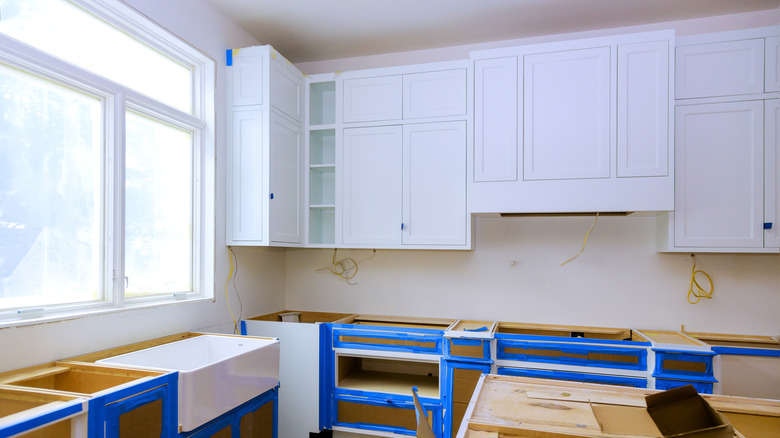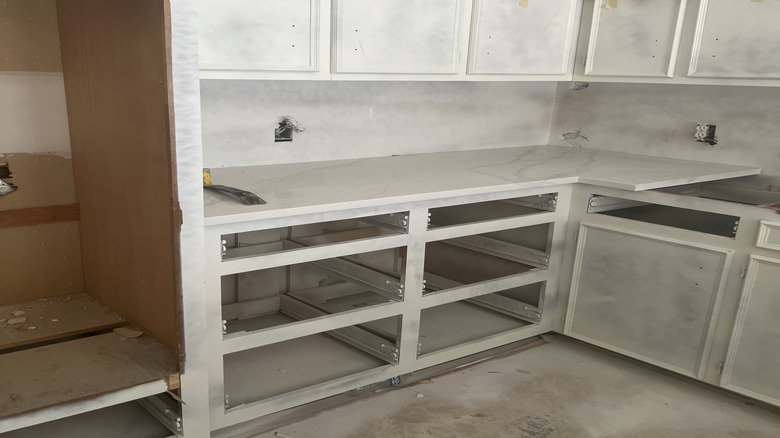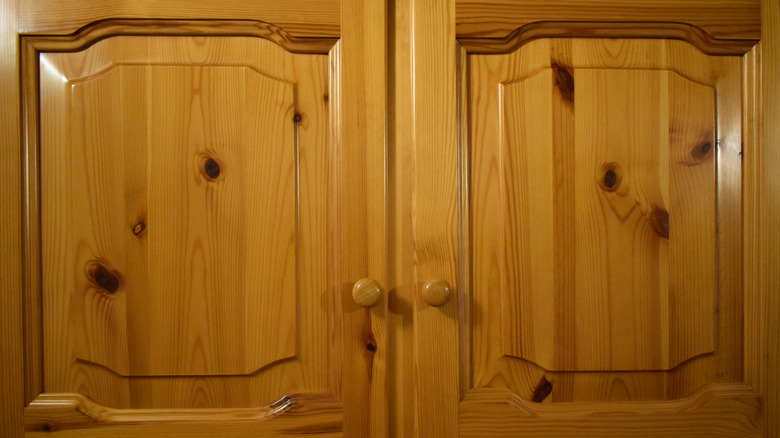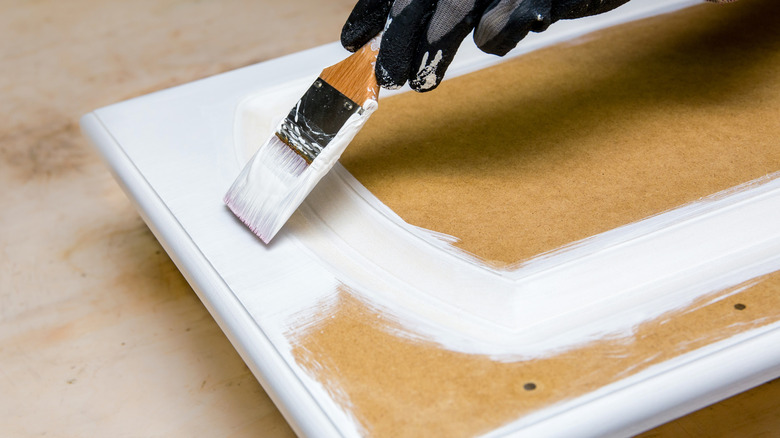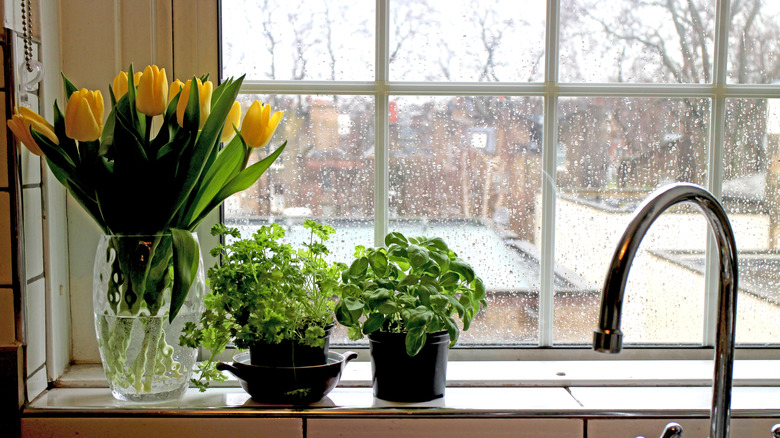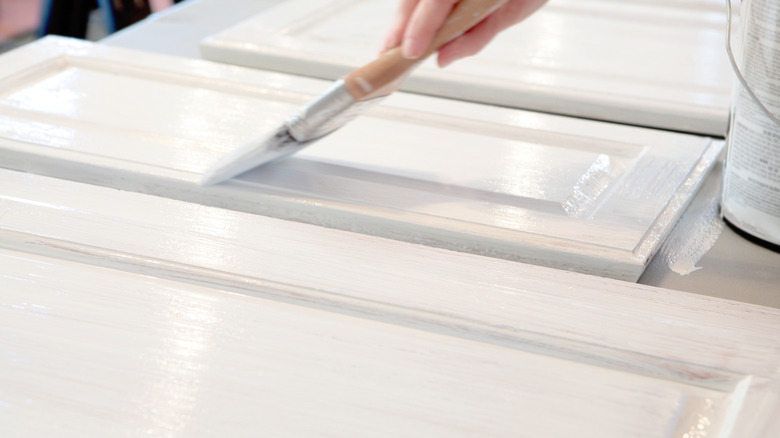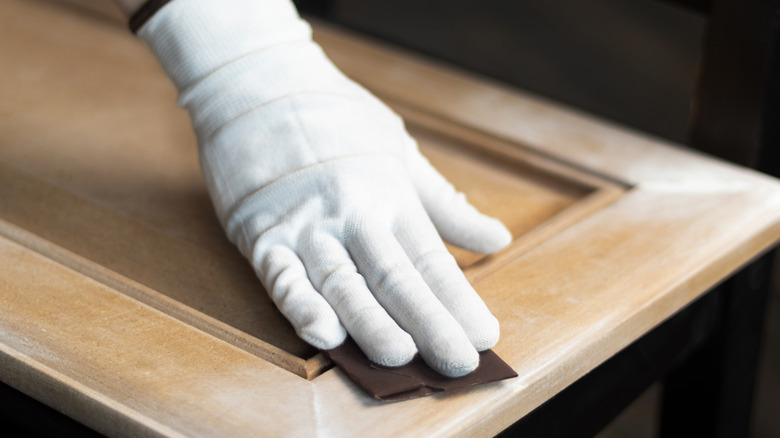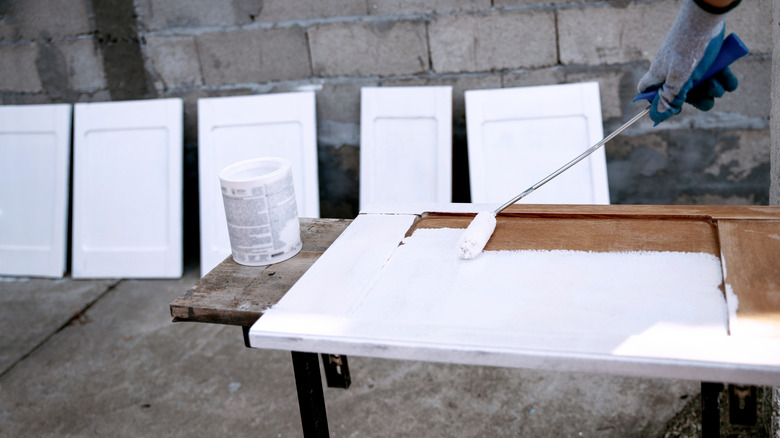7 Tips And Tricks To Prevent Bleeding When Painting Cabinets
Ugh! You thought you were so careful to avoid making a mistake when painting your cabinets. However, after that coat of white paint dried, you noticed that the original wood finish underneath had bled through. So, now instead of that clean and fresh look you were trying to give to your room, the cabinets are screaming dirty and dingy. Unfortunately, your cabinets were a victim of tannin bleed. This is a phenomenon that occurs when the tannins (which are naturally occurring compounds in wood responsible for giving each variety its unique color), interact with the chemicals found in paint. This interaction causes the tannins in the wood to be replaced, after which they move through the paint layer and end up on the surface of your newly painted cabinet.
To help you avoid this highly frustrating situation, we reached out to some experts to help uncover some of the best ways to prevent tannin bleed from occurring when painting cabinets. Whether you've already painted your cabinets and need to know how to fix the bleeding or haven't yet started your painting project and want to prevent it from occurring in the first place, you've come to the right place. The exclusive advice shared by our experts will provide you with key tips to help avert the disaster that tannin bleed can cause.
Use a shellac-based primer to prevent the tannins from being released from the wood
You likely know that applying primer is an important step before painting cabinets. However, if you don't use the right type of primer, the results may not be what you're looking for, and the tannins may still bleed. During an exclusive interview, Kelly Mardis, the owner of Marcel Painting, shares that he recommends using a shellac-based primer on cabinets before painting them.
Mardis explains that this type of primer "closes off all the pores in the wood and keeps the tannins in the wood from releasing and bleeding through your new paint." He recommends using a brush (natural or synthetic will work) to apply the primer to your cabinets to trap in the tannins before moving on to painting the surface.
For greater effectiveness, spot treat knots before painting
Knots and heavy-grained areas are more tannin-rich than other sections of the wood. Giving these spots a little extra TLC before you begin painting — or even priming — your cabinets can help ensure that the tannins aren't able to seep through the paint and discolor the surface. Bree Steele, an interior designer and trade accounts manager at RJ Living, tells House Digest that she recommends sealing knots and other more heavily-grained portions of each cabinet door before priming.
During an exclusive interview, she shares, "For cabinets with wood knots or very porous grain, spot-seal these areas with a shellac-based sealer before priming. It's an extra layer of protection that keeps those problem spots hidden." If you don't have any sealer on hand, Timothy Wood, the founder and CEO of Fix It Today, explains that you can also use a shellac-based primer to spot treat these knots and more tannin-rich areas. He also notes that, "it may be necessary to apply two coats for particularly tannin-rich woods like mahogany or pine." Once you've spot-treated the knots and let the primer dry, apply a second (or third) layer of primer over the entire cabinet door to ensure the surface is fully prepped for painting.
Consider using an enamel paint for your wood cabinets
If you don't use the right type of paint on your wood cabinets, then you are just opening the door for a problem with tannin bleed. Yan Margulis, a renovation expert at Capable Group, shares a word of caution with House Digest during an exclusive interview. He says, "Never use water-based paints directly on raw wood because they can activate the tannins and make things worse." Both acrylic and latex paints are water-based, so using them could prove problematic, especially on bare wood or over a primer that doesn't have good stain-blocking abilities.
Timothy Wood highlights enamel paint as the best for painting cabinets. "It is specifically formulated for wooden surfaces," he says. Moreover, Wood names enamel paints as "the best at preventing wood tannins from seeping through." Steele recommends choosing a semi-gloss or satin finish. She explains that these finishes "work great for cabinets as they're easy to clean and maintain." If you do prefer to use an acrylic paint on your cabinets (thanks to the easier clean-up and lower VOCs), you might want to test a small patch on an (inconspicuously-placed) tannin-rich knot first. Also, bleed-through is most noticeable on white cabinets, and typically less of a problem with dark, saturated colors. So if you've been endlessly browsing navy blue kitchen ideas, you may be able to get away with acrylic on your cabinets — but be aware that it may not be as hardwearing as enamel. If you're opting for a white kitchen, then enamel is probably your best bet.
Avoid painting in humid conditions
Before deciding when you're going to undertake the project of painting your kitchen cabinets, don't forget to check the weather. Even when you've taken other precautions — such as applying a shellac-based primer and choosing the right type of paint for the cabinets — Timothy Wood cautions against painting on overly humid days. He explains, "Humidity tends to draw tannins out of the wood." So, think twice before painting on a rainy day or a hot and humid summer day when there will be more moisture in the air.
If you need to complete the project on a certain day, or the forecast is showing no reprieve from the current conditions, Wood says, "use a dehumidifier if it's especially humid during the day you're painting." Be sure to consider the size of your space to choose an appropriately sized dehumidifier, and consider getting it up and running a while before you're ready to start painting. This way, it will have a chance to bring down the humidity levels in your kitchen before any paint or primer touches the cabinets.
Apply multiple coats of paint to the cabinets
While a single coat of paint might look like it provides sufficient coverage for your cabinets, it's probably not. You may wake up the following morning to notice that the tannins have bled through that coat. This is why Yan Margulis explains, "It is recommended to apply at least two coats of good-quality paint over the primer." Beyond helping keep the tannins from bleeding, applying two coats of paint can also help deliver a cleaner finished product. The cabinets will look more even, and you'll be less likely to see evidence of brush marks or other imperfections.
Margulis explains that one coat of primer may not always be sufficient, either. He says, "On cabinets that are particularly prone to bleed-through, such as those made of oak or pine, I sometimes apply a second coat of primer for complete coverage." When in doubt, apply two coats of primer, followed by two or more coats of paint to help prevent the tannins from bleeding and to ensure a smooth and clean look.
Prep the wood thoroughly before painting
When you've made the decision to give your cabinets a facelift by painting them, it is understandable that you're eager to start seeing the changes. This may cause you to skip some critical steps in the process. Bree Steele shares a word of caution against overlooking the importance of prepping your kitchen cabinets before painting them.
Steele says, "I couldn't stress enough about the importance of sanding." According to her, "Sanding removes any existing finishes or glossy surfaces, and it makes sure the primer adheres properly and minimizes the risk of tannins from the wood seeping through." So, even if you're eager to start seeing the new look of your space come together, keep reminding yourself that some patience and attention to detail will pay dividends in the end by delivering a pro-level look and erasing any danger of having to repaint your cabinets in the near future.
Let each coat of paint or primer dry fully before applying additional coats
You may also be tempted to speed things along by applying the additional coats of paint or primer before the one beneath it has had a chance to dry thoroughly. However, according to Bree Steele, this is another mistake that could end up costing you. She says, "Let each layer (primer, paint, and sealant) dry fully before applying the next." Remember, the ideal time between applying a new coat of paint can vary based on the type of paint you're using and the temperature and humidity levels, so always check the can for instructions.
Steele explains that if you don't leave sufficient time for each coat to dry fully that it "can cause bleed-through to appear later, even if the surface looks good initially." This means that you might not even realize you have a problem until after you think you've finished painting the cabinets. Immediately after painting, they might look perfect, but a few hours later or the following day, there might be some discoloration from the tannins seeping through.
